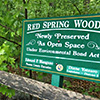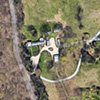Inside the land deals that benefited connected Long Islanders
In some cases, sellers got market-value price from government while continuing to live beside the land, keeping access to property that would have been hard to otherwise develop.
In 2001, as Thomas Suozzi prepared to take office as Nassau’s first Democratic county executive in decades, he looked for new ideas to fix the deficit-ridden budget he’d inherit.
To urge county employees to be part of the process, Suozzi created a $20,000 fund of private donations to reward their best ideas. He named two businessmen to oversee it and hand out the prizes.
One was Michael Held, a campaign supporter and former Oyster Bay Cove village planning board chairman who ran a stationery company.
“Who better to come up with ideas to save money in county government than the employees themselves?” Held said at the news conference, where he stood with Suozzi to announce the fund.
Years later, Held became a beneficiary of another of Suozzi’s initiatives. In 2009, the county bought 8 acres of Held’s property in Oyster Bay Cove for $2.9 million — part of the $100 million it spent on open space preservation under Nassau’s landmark Environmental Bond Acts.
A Newsday investigation found that roughly $30 million of that money, both under Suozzi and his successor, Republican Edward Mangano, was paid to political contributors and people with ties to county politics, the property selection process;or both.
Those who helped shape the program say that sellers’ political connections weren’t relevant to the process that resulted in properties such as Held’s being recommended for purchase. Others say those types of connections weren’t even brought to their attention – the county then didn’t strictly enforce the submission of forms for disclosure of campaign contributions or other political ties.
In Held’s case, the land met some of the top criteria set by the Suozzi-appointed advisory committees that ranked nominations and recommended them for purchase: It was part of the state-designated Special Groundwater Protection Area along the North Shore and was adjacent to existing open space, the county’s Tiffany Creek Preserve.
But the Held acquisition – one of several in Oyster Bay Cove involving connected sellers – also had some of the characteristics that have drawn criticism: The county purchased it for $105,000 more than its highest appraised value and about $230,000 more than what the county had assessed as the market value of the entire 13.6-acre Held estate, including the home.
His sold-off 8 acres, featuring a spring-fed pond and some trails, expanded the rear portion of the 200-acre Tiffany Creek Preserve by 4 percent, with the only public access remaining through the front of the preserve, a roughly two-mile hike from the Held site.
On the county’s land records website, a search of the purchased parcel still yields the description; “inaccessible vacant land.”
That final sale price, however, was reduced from an even higher figure, said the former Suozzi aide who helped negotiate the deal with Held.
“He had really ridiculous ideas of what his property was worth and we kind of whittled down to where we were,” Sean Rainey, then the county’s deputy real estate director, said of Held, noting that while he appreciated the natural beauty of the land, “the committee made recommendations of what they wanted to buy. I didn’t make that decision.”
Held said in a brief interview that he never dealt directly with Suozzi in negotiations and didn’t believe his prior appointment by him provided him with any special treatment.
“I think many of the people who wound up selling to the county knew people involved,” he said.
Suozzi declined to comment on individual bond act acquisitions, but in a brief interview he noted that all properties bought by his administration “went through a rigorous process” of review and were for prices in the general range of fair market value. His environmental coordinator, Tom Maher, said the county executive – now a congressman – did not interfere with the advisory committees that reviewed nominations and recommended purchases. The committees, as Newsday has reported, were largely appointed by Suozzi and consisted of several environmentalists as well as civic leaders with ties to the county Democratic Party.
“Tom stayed away from it and just left it up to the committee,” Maher said.
The environmental bond programs, passed overwhelmingly by voters in 2004 and 2006, apportioned $100 million for acquisition of open space, with priorities to parcels critical to groundwater protection, near existing preserves or under development pressure. The process laid out by the referendums required parcels to be nominated to – and then recommended for purchase by – the advisory committees.
Suozzi’s office signed off on the recommendations after obtaining approval from the county’s Planning Commission and Open Space and Parks Advisory Committee. Finally, at least 13 of the 19 county legislators needed to vote on all purchases.
But at each of those steps, Newsday found, sellers’ ties to county politicians or the property selection process were never prominently raised. Some advisory committee members said they were never presented with any of those details.
Held acknowledged that he’s heard general complaints about deals like his, in which the seller benefits by getting a market-value price from government, yet by continuing to live alongside it, retains de facto access to a plot where extracting a profit may have otherwise been difficult. One of the appraisals commissioned by the county said the parcel was “impacted by wetlands restrictions that limit its development potential.”
The difficulties of building on the land notwithstanding, Held said if the county didn’t buy it, “we probably would have developed it and put a number of houses on the piece.”
“What people don’t say is the amount of taxes you’re paying on the piece year after year after year, and it’s not like if you don’t develop it you get any kind of tax relief,” he said.
Just down the road from Held’s land, a series of bond act purchases helped create a new county preserve. But it also allowed Suozzi political contributors and donors to the nonprofit that helped shape the open space program to sell off parts of their property at market value and lower their tax burden by reducing the size of their estates.
The Pulling Estate
One of the first deals closed under the environmental bond acts was the 2006 purchase, for $6.5 million, of 16 acres at a prominent corner of Oyster Bay Cove that had been the subject of development speculation for years.
The land was part of a once-150-acre family holding controlled by banking executive Thomas Pulling, who was executor of his father’s estate along with JPMorgan Chase Bank. Pulling acknowledged being a longtime Suozzi contributor;and in 2006 had given at least $10,000 to the North Shore Land Alliance, the nonprofit that had lobbied for the bond acts and whose president and CEO, Lisa Ott, had a prominent role on the county advisory committee that recommended purchases.
County campaign finance records from before 2006 are no longer available, but Pulling contributed $500 to Suozzi’s unsuccessful bid for governor in January 2006, about a month before the county announced that the site was one of six it was targeting with the first bond funds.
Pulling, a Republican who that year contributed to no other Democrats on Long Island, gave Suozzi’s campaign another $250 in August 2006, a month after the Nassau County Legislature approved the sale. During Suozzi’s unsuccessful 2009 and 2013 county executive runs, he contributed $3,450, and has since given Suozzi’s 2016 and 2018 congressional campaigns a total of $2,000.
“There was absolutely no connection between the two,” Pulling said of the land deal and his contributions to Suozzi, who he said has become a good friend. “I’ve just supported Tom, probably, well before this property deal came along and ever since, including now that he’s in Congress.”
In 2006, Pulling also donated between $10,000 and $24,999 to the Land Alliance, making him one of its biggest benefactors that calendar year (there were only six individuals or families that had given $25,000 or more), according to a group newsletter that did not pinpoint the precise amount of donors’ gifts. He said that money wasn’t meant to help along the deal but rather came at the request of nonprofit board members.
Ott said the contribution came at a wine auction in September 2006, after the Pulling deal with the county had received legislative approval, and helped the nonprofit create a “quick action” fund for subsequent preservation efforts.
Pulling acknowledged at first being skeptical of selling a portion of his land to the county – a developer still plans to put homes on a large portion of it on the opposite side of his estate. But he said he was finally convinced when he realized that the county wasn’t asking for donation of the property but would pay a price comparable to what he might make had he built there.
“As an executor of my father’s estate, I had to do as well as I could for the estate,” he said. “And it never occurred to me that the county would pay the highest value.”
Creating a preserve
After securing Pulling’s property during the first $50 million environmental bond act, the county looked to extend its land there after securing the second round of funding – $100 million – which passed in a 2006 referendum promoted by the Land Alliance. The nonprofit that fall had pumped $222,000 into a political action committee to fund pro-bond mailers and television ads, records show.
With the additional open space money secured, a second advisory committee in 2007 recommended more properties for preservation. Among those purchased in 2008 were two that joined the former Pulling property to establish a nearly 30-acre preserve. One was a 7.2-acre parcel owned by one of Pulling’s sisters, bought for $3 million; the other was 5.9 acres of the adjoining Schwab estate, acquired for $2 million.
The three pieces of land created the Red Cote Preserve at the corner of Route 25A and Yellow Cote Road in Oyster Bay Cove. Like Pulling in 2006, his sister Lucy Cutting and her husband, George, were top Land Alliance backers when their land was nominated for the extension and then acquired, contributing between $10,000 and $24,999 in 2007 and between $10,000 and $50,000 in 2008, according to the nonprofit’s newsletter.
Referring to the contributions that Pulling and the Cuttings made to her organization, Ott said they had no impact on the purchase recommendations by the advisory committees, both of which she served on. She noted that both properties, based on their features and location in the groundwater protection area, had already been identified as preservation priorities in a state open space report.
“It really didn’t matter who owned them,” Ott wrote in an email, noting that the Cutting contribution helped create a fund to maintain the Red Cote Preserve. “They met the objectives of the program.”
The owners of the adjacent parcel, Hermann C. Schwab, a former Oyster Bay Cove mayor, and his wife, Meteer, nominated their land for county acquisition in 2005, during the first environmental bond act period, county records show. This was when their daughter-in-law, Katie Schwab, was Suozzi’s deputy planning commissioner and was on the Land Alliance’s advisory board and the first county advisory committee that reviewed nominations and recommended the adjacent Pulling land, records show.
Katie Schwab left her county job at the end of 2005, stepped down from the Land Alliance advisory board and, in 2007, completed her divorce with Hermann and Meteer Schwab’s son, George, records show. The county ultimately purchased her former in-laws’ land in 2008, for the $2 million price that was slightly less than the $2.4 million its assessment department had valued the couple’s entire 11-acre estate, with their home.
Suozzi administration officials acknowledged to county legislators at the time that there were no imminent plans to develop the land, but justified the purchase as a way to add onto the just-purchased Pulling land.
“I think that, generally, these people really wanted to just leave some legacy behind, so I think that’s why they were really pushing for this,” Rainey, referring to the Schwabs, told legislators during the 2008 legislative committee meeting where the purchase was approved.
Hermann Schwab died in 2013. Katie Schwab declined an interview request but provided a statement: “I was not aware that my former in-laws’ parcel of land was purchased until after the fact, and I had no role whatsoever in the County’s decision.”
George Schwab, an attorney, said he was involved in the Land Alliance and assisted his parents in the sale. He recalled that his ex-wife “certainly would have been in favor of us trying to sell the land,” but that he dealt directly with the county’s real estate attorneys to get the deal done.
“I may have called her and asked her some questions,” he said of Katie Schwab, noting that they had an amicable divorce, but he did not recall her being part of the process following her departure from the county.
“Katie Schwab got us nothing extra, or nothing we wouldn’t have gotten anyway,” he said.
The Red Cote Preserve also ensured that there would never be development in the shadow of one influential couple with property across the street: Elia “Aly” Lizza, president of Carlo Lizza and Sons Paving Inc., and his wife, Marisa, who gave money to the Land Alliance during the years the group was pushing for the nearby open space buys. She is listed in Land Alliance newsletters as having given “$99 and below” in 2006 and “up to $499” in 2008.
Marisa Lizza, whose husband’s firm won more than $100 million in paving contracts from Nassau between 2002 and 2016, also gave Suozzi large campaign contributions at times when the county was pushing for preservation of the neighboring land, records show: $16,000 to his bid for governor in July 2006, days before Pulling signed his contract with the county; and $25,000 to his county executive campaign in June 2008, about a month before both the Schwabs and the owner of the other adjacent parcel signed their contracts of sale.
“The day after your neighbor puts their land into open space, your property value goes up,” said Daniel Press, a professor of environmental studies at the University of California Santa Cruz who has written extensively on government land preservation. “So there’s this windfall for people who are adjacent to permanently protected open space because they’re going to have this … permanent buffer.”
Marc Gann, Marisa Lizza’s Mineola attorney, declined to comment on behalf of his client. Marisa and Elia Lizza were indicted last year by the Nassau district attorney in an unrelated public corruption case involving land deals in the Town of Oyster Bay. They have pleaded not guilty.
The Smithers Estate
Much of the land acquired in affluent North Shore communities was already zoned to provide as little density as possible, meaning that preservation, as opposed to elsewhere on Long Island, meant stopping the development of just a handful of homes at most.
The $7.8 million purchase of 25 acres of the Smithers estate in Mill Neck Village in 2008 was the most extreme example. The land, which was owned by wealthy philanthropist Adele Smithers, the estate of her late husband, R. Brinkley Smithers, and the anti-alcoholism foundation she ran, could not have accommodated more than three or four new homes due to strict village zoning laws.
“For most people, I think their understanding is, if the county is going to spend $8 million or $10 million, they’re going to go out there and save the property from being massively developed by corporate buildings, by dense housing and stuff,” Richard Nicolello, a Republican county legislator who now serves as presiding officer, said at the 2008 hearing where the Smithers property was first debated.
As a comparison, a half-acre site in Point Lookout, on the South Shore, that was recommended for preservation but not purchased later was sold for three new homes. A five-acre farm the county saved in Malverne, also on the South Shore, could have yielded 33 single-family homes – a typical number for the more-densely zoned area.
Though Mill Neck and other North Shore villages have long had multi-acre zoning that prevents condo communities or tightly packed single-family homes, Ott says the ever-changing composition of local village leadership means that no zoning restrictions are permanent – while an open space acquisition is.
“With new mayors come new changes of rule, so if something is five-acre zoned today, that doesn’t mean it’s going to be in five years,” she said.
The density issue was debated at the time of the purchase, but the seller’s status as a Suozzi campaign contributor was not, records show. No disclosure form was filed with the contract documents provided by the county, though other open space deals included them.
In the 18 months leading up to Smithers’ contract of sale with Nassau, Smithers, a Republican, had contributed a combined $13,000 to Suozzi’s 2006 gubernatorial bid and his county executive re-election campaign. After the deal was closed, she gave another $5,500 to Suozzi’s subsequent campaigns over the next five years.
Smithers, who died last year at age 83, was the aunt of State Sen. Tom Croci (R-Bay Shore), who served as one of the family’s contacts during negotiations, before his first election to public office.
Mangano takes helm
Mangano took office in January 2010 with the vast majority of open space funds already spent. He did, however, close a deal that had been discussed for years: purchase of the 4.2 acre Brooklyn Water Works property in Freeport.
Under Suozzi, negotiations with the politically influential property owner Gary Melius, who also owns Oheka Castle, had stalled. As Newsday reported in its detailed investigation of Melius’ life in February, the Suozzi administration had twice appraised the property as worth no more than $2.7 million.
“We did make him an offer, and he laughed,” Maher testified to county legislators in 2008 about negotiations with Melius.
Under Mangano – whom Melius had befriended and supported, to that point, with roughly $15,000 in campaign contributions – the county appraised the property at a minimum of $6.3 million. It cited Melius’ ability to develop the land into as many as 121 condominiums.
The acquisition was completed in September 2012, at a price of $6.2 million.
But, as Newsday reported, Melius did not have permission to build all those condos and, under Freeport village’s density restriction of 75 units on the property, would have had to have gotten significant variances to allow for the proposed building heights and required parking. On top of that, environmentalists had long opposed Melius’ plans, wanting the site, which abuts a nature preserve, to remain open space.
The increased sale price, all but exhausting what money remained in the bond act funds for open space purposes, caused the county to pay for the last $1.7 million using more than half of what remained in a separate open space account. That account is funded by 5 percent of proceeds from each general county real estate sale and at the time had about $2.9 million available.
Under Mangano, that open space account was also tapped in 2013 and 2014 to pay $45,000 to an engineering firm that had drawn up never fully realized plans to enhance public access at several open space sites.
Nelson & Pope Engineers & Surveyors, which was on retainer for general county engineering work – and had done open space design work for many municipalities – employed the wife of Mangano’s then-chief deputy, Rob Walker, as well as Walker’s mother, Rose Marie Walker, a county legislator.
Mangano, who left office at the end of last year, recently stood trial on unrelated federal public corruption charges, with the case ending in a mistrial. Rob Walker has pleaded not guilty to federal charges of obstructing justice and lying to federal agents in an unrelated case.
Brian Griffin, an attorney for Walker, said in a statement that Walker always disclosed his wife’s job with the engineering firm and his signoffs on the pacts “were nothing more than ministerial after the legislature awarded any contracts.”
In 2014, instead of considering previously recommended parcels that hadn’t been purchased, the Mangano administration decided to spend $800,000 in open space funds on a .7-acre lot in Bethpage that hadn’t been on anyone’s radar.
The lot, once an old nursery, was owned by Mangano’s longtime friend and deputy parks commissioner Frank Camerlengo and had fallen into foreclosure proceedings and disrepair, with landscaping trucks stored on it. The proposal never got past the planning commission after questions about the land’s appropriateness and the seller’s connections were raised.
“It got shot down pretty early in that process,” said Neal Lewis, a county planning commission member who served on the two environmental bond act advisory committees. The commission had just started reviewing the proposal when Newsday wrote about it, drawing widespread outrage.
“But, still, it was quite a moment, where it was like, ‘What are we even talking about here?'”
Lewis, who spoke highly of the overall environmental bond program, expressed surprise when told previous deals that came before the commission also involved county political appointees or people with ties to them.
“I’m a little disturbed,” he said. “I’d hate to think that someone might have pulled a fast one.”
Do you have information on any other sites purchased under Nassau’s environmental bond acts that remain obscured, hidden or lack sufficient public access? Contact Paul LaRocco at (631) 843-2736 or paul.larocco@newsday.com.

 Overview:
Overview: Map:
Map: Part 1:
Part 1: Part 2:
Part 2: Part 3:
Part 3:


 Video:
Video: